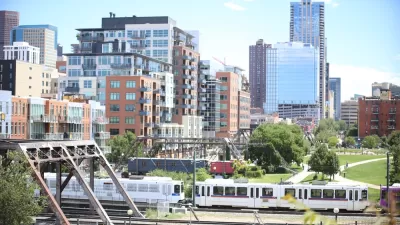An isolated train station north of Denver could become a hub of housing and commercial activity.

After two years of serving local commuters with train service but no other nearby amenities, the lone train station in Commerce City, north of Denver, could become a hub of activity as the city approves new housing and commercial uses in the area to support more transit-oriented development. John Aguilar of the Denver Post reports that the city has approved a 100-unit affordable housing development to kick off development at the site.
“According to RTD [Regional Transportation District], nearly 3,400 transit-oriented development, or TOD, housing units were built in 2021 near stations across multiple rail lines in Denver, Lakewood and Aurora, as well as along the Flatiron Flyer bus rapid transit line on U.S. 36 that takes commuters from Denver to Broomfield and Boulder.” This year, the agency expects that roughly 6,000 multifamily units will be built around transit stations.
A report from the Urban Land Institute Colorado outlines the challenges and opportunities in the area surrounding the Commerce City station. On the plus side, the station is close to downtown Denver, and the nearby South Platte River could provide opportunities to build more amenities and connections. On the other hand, the report found a “lack of connectivity, access, safety, integrated green space, and community amenities,” as well as “fractured property ownership, a history of industrial activity and a lack of water rights in the immediate area.” City officials are looking to other train stations in the region as models for how to approach future development.
FULL STORY: Commerce City wants to turn its only rail stop into a destination

Maui's Vacation Rental Debate Turns Ugly
Verbal attacks, misinformation campaigns and fistfights plague a high-stakes debate to convert thousands of vacation rentals into long-term housing.

Planetizen Federal Action Tracker
A weekly monitor of how Trump’s orders and actions are impacting planners and planning in America.

In Urban Planning, AI Prompting Could be the New Design Thinking
Creativity has long been key to great urban design. What if we see AI as our new creative partner?

Massachusetts Budget Helps Close MBTA Budget Gap
The budget signed by Gov. Maura Healey includes $470 million in MBTA funding for the next fiscal year.

Milwaukee Launches Vision Zero Plan
Seven years after the city signed its Complete Streets Policy, the city is doubling down on its efforts to eliminate traffic deaths.

Portland Raises Parking Fees to Pay for Street Maintenance
The city is struggling to bridge a massive budget gap at the Bureau of Transportation, which largely depleted its reserves during the Civd-19 pandemic.
Urban Design for Planners 1: Software Tools
This six-course series explores essential urban design concepts using open source software and equips planners with the tools they need to participate fully in the urban design process.
Planning for Universal Design
Learn the tools for implementing Universal Design in planning regulations.
Gallatin County Department of Planning & Community Development
Heyer Gruel & Associates PA
JM Goldson LLC
City of Camden Redevelopment Agency
City of Astoria
Transportation Research & Education Center (TREC) at Portland State University
Jefferson Parish Government
Camden Redevelopment Agency
City of Claremont



























